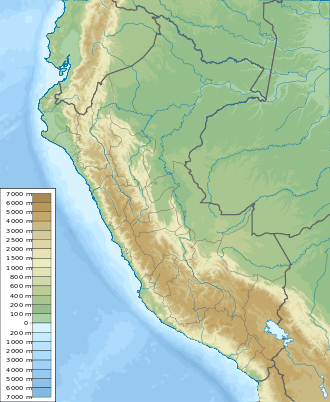Chanquillo
Chanquillo[1][2][3][4][5] or Chankillo[3][6][7][8] is an ancient monumental complex in the Peruvian coastal desert, found in the Casma-Sechin basin in the Ancash Department of Peru. The ruins include the hilltop Chankillo fort, the nearby Thirteen Towers solar observatory, and residential and gathering areas. The Thirteen Towers have been interpreted as an astronomical observatory built in the 4th century BC.[6][9] The culture that produced Chankillo is called the Casma/Sechin culture or the Sechin Complex.
Thirteen Towers of Chankillo, viewed from the fortress | |
 Shown within Peru | |
| Alternative name | Chankillo |
|---|---|
| Location | Ancash Region, Peru |
| Coordinates | 09°33′24″S 78°14′09″W |
| Type | Fortified sanctuary |
| Part of | Casma/Sechin culture |
| Area | 4 km2 (1.5 sq mi) |
| History | |
| Founded | 300 BC |
The site covers about four square kilometres (1.5 square miles) and has been interpreted as a fortified temple.[7]
The Thirteen Towers solar observatory
The regularly-spaced thirteen towers of Chankillo were constructed atop the ridge of a low hill running near north to south, forming a "toothed" horizon with narrow gaps at regular intervals. To the east and west investigators designated two possible observation points. From these vantages, the 300m long spread of the towers along the horizon corresponds very closely to the rising and setting positions of the sun over the year,[9] albeit they are not all visible. On the winter solstice, the sun would rise behind the leftmost tower of Chankillo and rise behind each of the towers until it reached the rightmost tower six months later on the summer solstice, marking the passage of time.[10] The Thirteen Towers of Chankillo could be the earliest known observatory in the Americas. Inhabitants of Chankillo would have been able to determine an accurate date, with an error of a day or two, by observing the sunrise or sunset from the correct tower.[11]
The towers had been known to travelers for centuries, the astronomical function of the towers were speculated famously by Thor Heyerdahl in his book Kon-Tiki of the 1940s but only recently hypothesized at length in 2007 by Iván Ghezzi and Clive Ruggles.[12]
References
- Peru 1:100 000, La Caleta Culebras (20-g). IGN (Instituto Geográfico Nacional - Perú).
- Jenkins, Dilwyn (2003). The Rough Guide to Peru. Rough Guides. p. 295. ISBN 9781843530749.
- Pozorski, Shelia; Pozorski, Thomas; Pozorski, Thomas George (2006). Early Settlement and Subsistence in the Casma Valley, Peru. University of Iowa Press. p. 95. ISBN 9781587294624.
- Gerster, Georg (2005). The Past from Above: Aerial Photographs of Archaeological Sites. Getty Publications. pp. 197. ISBN 9780892368754.
- "SITIO ARQUEOLOGICO CHANQUILLO" (in Spanish). MINCETUR. Retrieved 2017-06-01.
- Ghezzi, Ivan; Ruggles, Clive (2007). "Chankillo: A 2300-Year-Old Solar Observatory in Coastal Peru". Science. 315 (5816): 1239–1243. Bibcode:2007Sci...315.1239G. doi:10.1126/science.1136415. ISSN 0036-8075. PMID 17332405.
- Ghezzi, Ivan (2006). "Religious Warfare at Chankillo". In Isbell, William H.; Silverman, Helaine (eds.). Andean Archaeology III. Springer US. pp. 67–84. doi:10.1007/0-387-28940-2_4. ISBN 9780387289397.
- DK (2010-06-21). Space: A Visual Encyclopedia. Penguin. p. 209. ISBN 9780756666286.
- BBC/Open University documentary, Broadcast March 2011, Downloadable demonstration of Towers at sunrise.
- "Archaeoastronomy".
- "Chankillo".
- Atwood, Roger. " "Solar Observatory at Chankillo, Peru." Archaeology. Volume 61 Number 1, January/February 2008. http://www.archaeology.org/0801/topten/solar_observatory.html.
External links
- 3D reconstruction of the site
- Chankillo, Peru, Ancient Solar Observatory?
- Towers point to ancient Sun cult, BBC
- Giant Solar Calendar Measures Time, BBC
- Early Monumental Architecture on the Peruvian Coast
- Yale University article: Peruvian Citadel is Site of Earliest Ancient Solar Observatory in the Americas and slide show
- View from the air on the Chankillo site
- High-resolution image of the Thirteen Towers
- Wonders of the Universe, Prof. Brian Cox, BBC (maybe region locked to UK only)
.jpg)